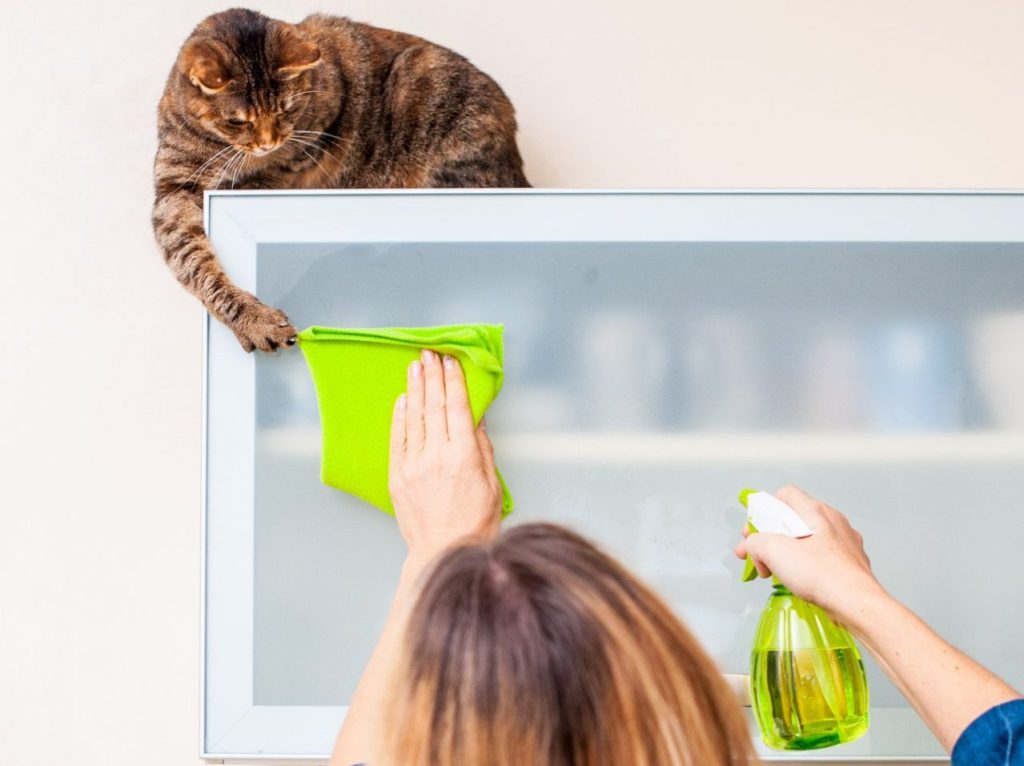Cats are mischievous by nature. This personality trait can be endearing at times and frustrating at others. As a cat parent, you likely seek effective methods to train your feline friend. Who doesn’t want to promote positive behaviors while simultaneously discouraging unwanted ones? However, the use of a spray bottle as a training tool is a controversial topic among cat lovers. We’re going to unpack the practice of using a spray bottle to train a cat, highlighting why it is not an acceptable form of behavior modification. Then, we’ll explore alternative, gentler methods to train your four-legged family member.
Why people use spray bottles on their cats
The short answer: naivite and desperation. Some cat parents resort to using spray bottles as a training tool to deter unwanted behaviors such as scratching furniture, jumping on counters, drinking from the faucet, or excessive meowing. The idea behind this technique is to startle or annoy the cat with a spray of water. This is done in hopes your kitty will associate the negative experience with her behavior, thusly discouraging its repetition.
Why you should never use a spray bottle to train your cat
There are many reasons why using a spray bottle on a cat is considered inhumane.
Negative associations and fear
Using a spray bottle can create negative associations and fear in cats. Instead of effectively addressing the behavior, it may cause the cat to become anxious, stressed, or even fearful of their cat parent. Such a strong emotional reaction can strain the bond of trust between the cat and their parent.
Ineffective long-term results
While a spray bottle may yield immediate results by interrupting unwanted behavior, it often fails to provide a long-term solution. Cats may simply learn to avoid the spray bottle or revert to unwanted behavior when the cat parent is not present. This undermines the effectiveness of the training method and may lead to frustration on both sides.
Interference with positive reinforcement
Using punishment-based techniques like spray bottles can hinder the adoption of positive reinforcement strategies, which are proven to be more effective in cat training. Instead of focusing on rewarding desirable behaviors, the emphasis shifts to punishing undesired actions. Undoubtedly, a cat parent misses out on opportunities to foster a positive learning environment for their feline friend when this happens.
Effective ways to train your cat without a spray bottle
Positive reinforcement
Rewarding your cat with treats, praise, or playtime when they exhibit desired behaviors is a highly effective training method. For example, provide a scratching post as an alternative to furniture and reward your cat when they use it. Positive reinforcement strengthens the bond between cat and cat parent while encouraging repeat behaviors.
Altering the environment
Cats have natural instincts to climb, scratch, and hunt. By providing appropriate outlets for these behaviors — such as scratching posts, interactive toys, and vertical spaces — you can redirect their energy and prevent unwanted behaviors. Creating a stimulating environment tailored to their needs promotes physical and mental well-being.
Consistency and clear communication
Establish consistent rules and boundaries, ensuring that all cat parents in the household follow the same guidelines. Use clear verbal cues or hand signals to communicate with your cat and reinforce behaviors consistently. Cats thrive in a structured environment where they understand expectations.
Redirect and distract
When you observe your cat engaging in undesired behavior, gently redirect their attention to a more appropriate activity. For instance, if your cat jumps on the counter, redirect them to a designated elevated perch or provide an interactive toy to engage their curiosity.
Seek professional guidance
If you encounter challenges in training your cat or need specialized guidance, consult a professional animal behaviorist or a certified cat trainer. They can offer expert advice tailored to your specific situation and provide effective training techniques to address your cat’s behaviors.
Coexisting peacefully with your cat
When it comes to training your fur baby, using a spray bottle is not recommended. Instead, focus on providing positive reinforcement, a stimulating environment, and consistent communication to foster a strong bond with your cat. By implementing these gentle and effective training methods, you can encourage desirable behaviors and create a harmonious relationship built on trust and respect.
Now that you know why you should never use a spray bottle on a cat, learn about proper cat training basics. Also, check out the top 10 cat breeds that actually love water!










